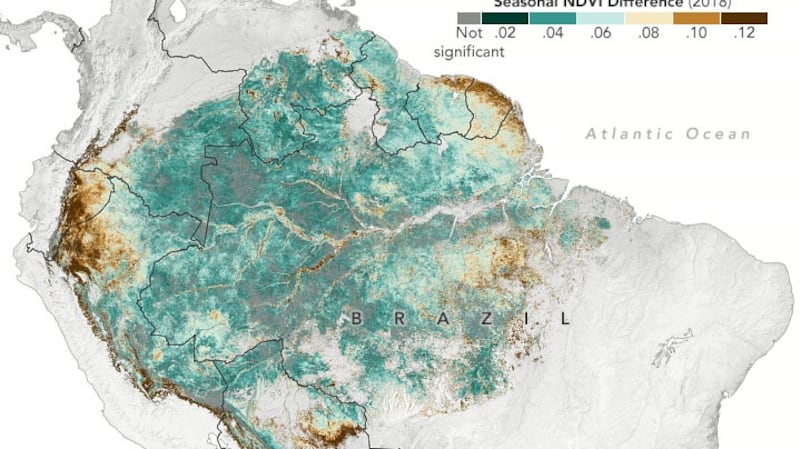The Amazon rainforest may be nearing a tipping point of "dieback", the point where it dries out and turns to savannah, climate scientists have concluded using satellites.
Their observational evidence shows accelerating “resilience loss” – the ability of an ecosystem to recover from a disturbance – with signs of “resilience loss in over 75 per cent of its area since the early 2000s”.
If this point is reached, it will have consequences across the planet as tropical forests such as the Amazon play a critical role in climate regulation.
Described as “the earth’s lung”, the Amazon is critical to the future of the planet, storing some 90 billion tonnes of CO2 in its trees and soil, though this has been declining.
Climate change and human-induced activities such as deforestation have been putting increasing pressure on the vast rainforest in recent decades.
Using satellite remote sensing data, a team led Dr Chris Boulton examined changes in the Amazon rainforest between 1991 and 2016. In findings published by Nature Climate Change, it combines satellite indications with data on forest cover and climate measurements to conclude "drier conditions and deforestation are likely pushing the Amazon towards a critical threshold".
This most prominent dieback is in areas closer to human activity and those with less rainfall. Loss of resilience does not coincide with a loss in the forest cover, implying the forest could be nearing a tipping point without showing changes in its “mean state”, they underline.
Reaching a tipping point, however, will have major impacts on biodiversity, global carbon storage and climate change. It is not clear when that critical point could be reached.

Resilience
The research was carried out by scientists at the University of Exeter (UE); Potsdam Institute for Climate Impact Research (PIK) and Technical University of Munich.
“The Amazon rainforest is a highly complex system, so it’s very difficult to predict if and when a tipping point could be reached,” explained Dr Boulton of UE Global Systems Institute.
“Our study looked in detail at month-to-month changes as the forest responded to fluctuating weather conditions. We studied metrics that are theoretically related to the rate of recovery after perturbations [external events that affect the forest], to see how resilience of the Amazon ecosystem has changed,” he added.
“Resilience dropped during the major droughts of 2005 and 2010, as part of an ongoing decline from the early 2000s to the most recent data in 2016. As a result, we would expect the forest to recover more slowly from a drought now than it would have 20 years ago.”
"Deforestation and climate change are likely to be the main drivers of this decline," said Prof Niklas Boers of PIK. "Many researchers have theorised that a tipping point could be reached, but our study provides vital empirical evidence that we are approaching that threshold."
Rainfall
Despite climate change, average rainfall in the Amazon has not changed dramatically in recent decades, but dry seasons have become longer and droughts more common and more severe. The study suggests overall biomass has declined slightly, but resilience loss is much more pronounced.
"The rainforest can look more or less the same, yet it can be losing resilience – making it slower to recover from a major event like a drought," said Prof Tim Lenton, director of the Global Systems Institute. They had provided "new compelling evidence to support efforts to reverse deforestation and degradation of the Amazon to give it back some resilience against ongoing climate change", he added.
“If too much resilience is lost, dieback may become inevitable – but that won’t become obvious until the major event that tips the system over,” Prof Boers added. “Many interlinked factors – including droughts, fires, deforestation, degradation and climate change – could combine to reduce resilience and trigger the crossing of a tipping point in the Amazon.”
When pressed at a briefing on how soon a tipping point might be reached, Prof Lenton said his hunch was within decades, though “fire feedbacks” could make it sooner. Prof Boers said Amazon dieback was happening faster than the melting of Greenland’s ice sheet.









